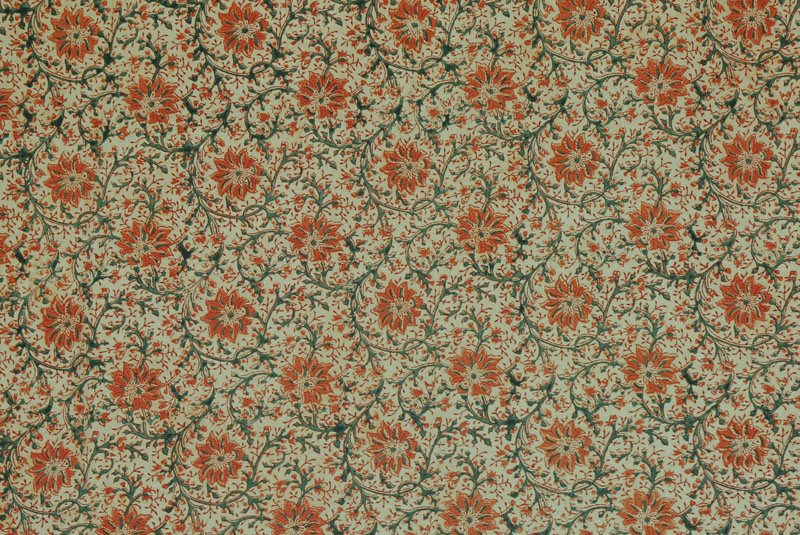Who in India has not heard about Kalamkari designs? Kalamkari—an art form where textiles are ‘painted’ or ‘crafted’ with a ‘pen’—comes from two words: Kalam, a Persian word meaning pen, and Kari, an Urdu word meaning craftsmanship. Ergo, ‘Kalamkari’ refers to all the various forms in which hand-painted fabrics using natural dyes exist.
The history of Kalamkari textiles goes back more than three thousand years. The earliest samples of fabric dyed with traditional Indian motifs have been found in Mohenjodaro’s excavations. Similarly, fabrics dyed with ‘Madder’—one of the oldest known dyes made from Madder root, Rubia tinctorum or Rubia cordifolia—have also been discovered in ancient Egyptian tombs while excavating Al Fustat near Cairo. Evidence suggests that Kalamkari was a thriving craft at the time.
Kalamkari art began in Hindu temples. It was a method of propagating religious knowledge to the commoners. Ergo, mythological themes dominated this art form; artists depicted scenes from Ramayana and Mahabharata on scrolls, temple backcloths, wall hangings, chariot banners, and so on. Put simply, it was a picture book of sorts that narrated stories of Hindu mythology on fabric.
As the artists, who were called ‘Qalamkars,’ were patronised by the kings of Golconda and Coromandel, the art form began to depict Persian influence. Later, under Mughal patronage, the craft became more secular.
During this time, Indian artisans used various natural dyes extracted from plants, seeds, flowers, roots, and minerals. The ‘pen‘ or ‘Qalam’ used for painting was made of a short piece of bamboo or date palm stick, which was sharpened at the end to form a nib. Even today, authentic Kalamkari textiles use vegetable dyes.
Earlier, the practice was closely guarded; rituals and superstitions accompanied it, and only a few practitioners had a hand in it. They kept the techniques secret; many took the secret to their grave. So, there are no written records to carry on the traditions of yielding colours from plants; there are no written manuals that give insights into traditional methods of producing Kalamkari art. Consequently, today, only a dozen ‘dye recipes’ are available compared to a hundred which used to exist earlier.
The unavailability of natural dyes, the use of cheap chemical dyes, and the employment of screen printing over block printing have led to the downfall of this beautiful art form; consequently, many works of art have been called out for being a fake reproductions of Kalamkari art.
There are two distinct schools of Kalamkari: the ‘Masulipatam school,’ which was patronised by the Muslim rulers, and the ‘Kalahasti school,’ which was dominated by Hindu temple art in medieval times. While the Kalahasti artists used ‘kalam’ or the pen for painting the prints, the Masulipatam artists used hand-carved blocks. The block method was preserved for a long time and passed down in time, changing hands and owners.
Dominated by temples, Kalahasti featured Hindu themes, and Masulipatnam designs featured the Persian heritage of the Mughals and the Golconda Sultanate. Persian motifs such as leaves, flowers, cartwheels, birds such as peacocks and parrots, creepers, and intricate designs were printed with blocks. During Aurangzeb’s reign, even personal portraits of emperors, depicting sagas of their rule and daily life, became popular. These gave accounts of the richness of their courts.
Trade in Kalamkari textiles has been evident since ancient times; however, during the seventeenth century, Masulipatnam was the primary centre from which textiles were exported, mainly to Persia. After the second half of the nineteenth century, Kalahasti became an important trade centre.
Kalamkari textiles are produced in small towns of Andhra Pradesh, where several small families of rural artisans and women carry out the gradual, laborious process within the household. It is passed from generation to generation. Today, the chief products from the Masulipatnam school are table and bed linen, curtains, dress materials, scarves, bags, file covers, cushions, and wall hangings.
Kalamkari is one of the most imitated Indian printing methods. The rising demand has kept Kalamkari from dying; however, it also harmed the art form due to the production of fake Kalamkari art with non-traditional printing methods. Apart from affecting the authenticity of the art, it has severe effects on the environment.
Kalamkari received Geographical Indicator (GI) status. It is an artform that takes India global.
-30-
Copyright©Madras Courier, All Rights Reserved. You may share using our article tools. Please don't cut articles from madrascourier.com and redistribute by email, post to the web, mobile phone or social media.Please send in your feed back and comments to [email protected]











